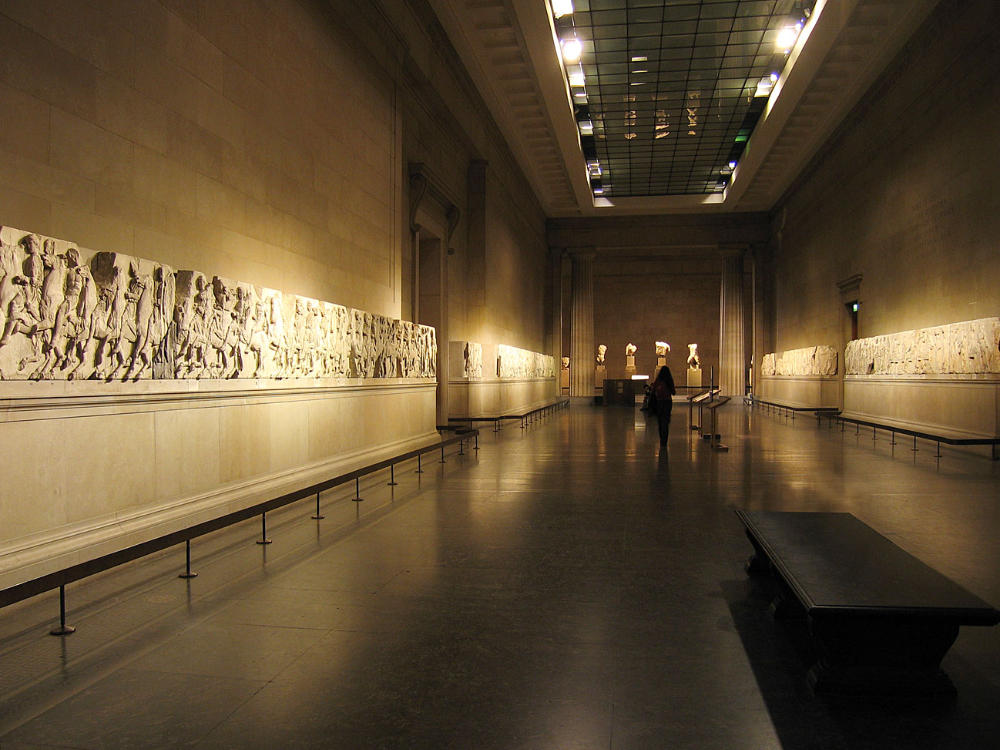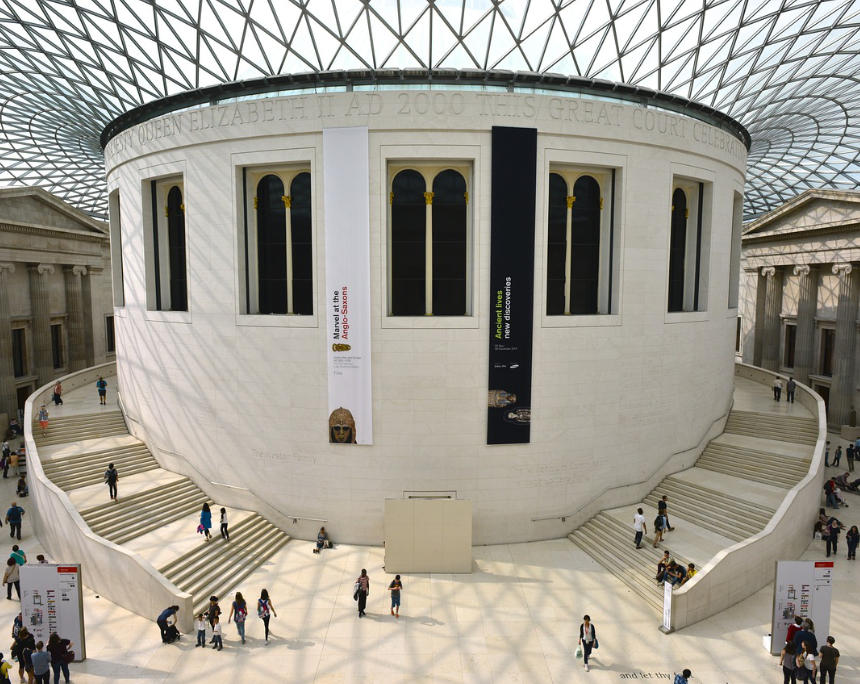Red Alert at the British Museum
by Björn Schöpe, translated by Maike Meßmann
The nightmare of any museum turned into reality for the British Museum: thousands of objects have disappeared – no one knows the exact figure. It appears that most of them had not been properly catalogued and were flogged off online. A curator is under investigation, Greece demands its Parthenon sculptures to be returned for safety reasons, the German director of the museum has stepped down – and this might just be the tip of the iceberg of what can now already be referred to as the largest theft in the institution’s history.
Content
Did a Curator Sell Objects of the British Museum?
Let us start at the end of the story. A few weeks ago, the British Museum sacked Peter Higgs. As a curator, he had been taking care of objects from the Mediterranean for more than thirty years. For the last two years, he had been Keeper of the Greek antiquities department. The museum accuses Higgs of having sold small objects online for years. The Daily Telegraph reports that when inspecting a storage room that should have held 942 unrecorded objects, only seven items were found. Higgs himself allegedly told the Sunday Times with regard to the stockrooms of the British Museum that “it’s chaos down there”.
The Economic Crime Command of the Metropolitan Police is investigating the case, and the British Museum has started to look into the matter itself. Both investigations will be difficult because most of the sold items had not been properly catalogued, and we might be talking about two thousand objects. A press release of the British Museum states that “the majority of the items in question were small pieces kept in a storeroom belonging to one of the Museum’s collections. They include gold jewellery and gems of semi-precious stones and glass dating from the 15th century BC to the 19th century AD. None had recently been on public display, and they were kept primarily for academic and research purposes.”
The Guardian mentions that “gold coins, silver necklaces and 540 pieces of pottery are among the hundreds of historical artefacts missing from the British Museum since 2013.”
In this context, The Times submitted a freedom of information (FoI) request that obliges public institutions to disclose certain pieces of information to the public. Responding to the request, the British Museum apparently disclosed that a Greek silver coin, a Roman coin from the 4th century (it was not mentioned whether we are talking BC or AD) and a German coin had disappeared over the twelve months leading to April 2014. Among the objects that have gone missing over the past decade were also an early 20th-century ring, a chain and other pieces of jewellery.
Numerous objects from the British Museum were offered on eBay by someone using a pseudonym, apparently significantly below market value to not draw attention to the sales. The Telegraph reports that a fragment of a Roman onyx cameo had been offered on eBay for £40; a dealer estimated its market value between £25,000 and £50,000.
But why does the British Museum believe that this seller might be its highly renowned curator Peter Higgs?
Did the British Museum Ignore the Warning of an Art Dealer?
The fact that the museum did eventually notice the loss of the many objects was thanks to investigations carried out by art dealer and gem expert Ittai Gradel. The latter explained in detail to The Telegraph how he uncovered the scandal. The short version goes like this: Gradel had been purchasing items from a certain eBay dealer for years. Since 2016, he had been suspicious. An offered cameo fragment seemed to be identical to a piece that had been published in a British Museum catalogue of 1926. However, it could have disappeared decades ago since it had not been included in updated inventory lists. Nothing suggested that a theft had occurred recently. In 2020, however, the same dealer offered another cameo fragment, and the art dealer found a photo of it on the website of the British Museum. Gradel then started doing some research on other pieces that he had purchased from this dealer over the years. He discovered that the PayPal account of the dealer was connected to a bank account under the name of Peter Higgs.
Let a brief remark be made at this point: Higgs and his family deny the allegations and, up to this point, no charges have been brought against him and he has not been arrested. The investigations are ongoing, which is why neither the police nor the British Museum want to disclose further details at this point. Although the museum has sacked the curator and considers him to be guilty, media outlets should not forget about the fact that he must be considered innocent until proven guilty. There are many possibilities when it comes to hacking accounts and using them for criminal acts.
In February 2021, Gradel sent his files to Jonathan Williams, the deputy director of the British Museum. It was not until five months later that Williams answered, stating that “the objects concerned are all accounted for” and the allegations were “wholly unfounded”. Following this, Gradel approached the museum’s trustees. In October 2022, Hartwig Fischer, the museum’s director himself, wrote to Gradel that a “thorough investigation” had been carried out and there was “no evidence to substantiate the allegations”. Gradel’s conclusion: “They treated me like some village idiot. I suppose they feared the scandal.”
After the British Museum announced what had happened in July 2023 and a public investigation was opened, Fischer accused Gradel of having obstructed the investigations at the time. He argued that Gradel did not make clear that so many objects in his possession were affected by this: “It’s frustrating that that was not revealed to us as it would have aided our investigations.”
The German newspaper FAZ clearly opposes Fischer’s statement: “Fischer does not seem to have read Gradel’s messages carefully. The letter that was ignored by the director for so long clearly stated that Gradel suspected a museum employee of having stolen more items than the three objects of which he had detailed evidence.” By now, Fischer had to admit that he was wrong.
In Germany, Hartwig Fischer’s Resignation Caused Much Speculation
On 28 July 2023, the British Museum announced that its director, Hartwig Fischer, would give up his post next year as soon as a successor had been appointed. The German art historian Fischer has been the first foreign director of the renowned institution since 1827. He became director in 2016 and was supposed to initiate reforms on various levels. It was now announced that these projects – the so-called “masterplan” – have all been completed or are well underway. Fischer himself explained that he was looking forward to new challenges “moving beyond the institutional framework of a single museum to engage in the rescue and preservation of cultural heritage in times of climate crisis, conflict, war, and violence.”
Especially in Germany, the resignation of the German scholar gave rise to speculations and extensive media coverage. The FAZ newspaper mentioned that Fischer mainly remained silent when Osborne, the former political heavyweight, negotiated the fate of the Elgin Marbles with Greece. These marble fragments had been transported from the Acropolis of Athens to England by Lord Elgin in the early 19th century with the approval of the Ottoman sultan, where Elgin sold them to the British Museum. Greece has long been demanding for the marbles to be returned. The FAZ assumes that Fischer was unable to assert himself in the often “ambiguous power structures” of the British museum world.
Barely a month later, on 25 August, Fischer was forced to resign with immediate effect. He had concluded that the museum had not responded appropriately to Gradel’s warning, and that he – as the museum’s director – had to assume responsibility. Moreover, Fischer explained that he wanted to take back his remarks about Gradel and to express his regret. He announced that he would step down as soon as an interim director was appointed.
How Does the British Museum Deal with the Loss of Cultural Assets?
Apparently, communication has not been the British Museum’s strong suit in this story. But what will happen now? George Osborne, the institution’s chair of trustees, described the next steps in a press release on 16 August 2023: “We called in the police, imposed emergency measures to increase security, set up an independent review into what happened and lessons to learn, and used all the disciplinary powers available to us to deal with the individual we believe to be responsible. Our priority is now threefold: first, to recover the stolen items; second, to find out what, if anything, could have been done to stop this; and third, to do whatever it takes, with investment in security and collection records, to make sure this doesn’t happen again.”

Are the days of the Elgin Marbles in the British Museum outnumbered? Photo: © Andrew Dunn / CC BY-SA 2.0
The Political Dimensions of the Theft at the British Museum
While London is trying to limit the damage, and no one knows exactly what skeletons might turn up throughout the investigation of the British Museum’s closets, Greece uses the scandal to pursue its own agenda.
In this context, the chair of the museum’s trustees – and former Chancellor of the Exchequer – George Osborne held talks with the Greek Prime Minister at the end of last year, which had initially been kept a secret. Now Greece is saying that the repeatedly voiced argument that the sculptures were safer in London than in Athens is invalid. Greek cultural assets are not being properly protected in the British Museum, quotes the BBC the Greek archaeologist Despoina Koutsoumba. Ironically, it was Peter Higgs – the person at the centre of the scandal – who had been promoted in 2021 to become acting keeper of Greek collections and thus the person responsible for the Parthenon sculptures. After the Greek Minister of Culture, Lina Mendoni, reiterated Greece’s demands, a British MP expressed outrage at Greece for turning the scandal into a political issue.
The Theft at the British Museum Is Not a Single Occurrence
It certainly cannot be of any consolation that the situation at other institutions is not significantly better than at the British Museum. Recently it was announced that more than 800 objects of the Canadian Museum of History went missing between 2012 and 2022. An investigation found that there was no working system to properly record the items.
As one of the most important and largest museums in the world, the British Museum must prove that its institution is able to properly protect and preserve the cultural assets that it is entrusted with. At a time when many countries are coming to terms with their history as colonial powers and objects are being returned to their countries of origin, the British Museum is a powder keg in Britain’s cultural landscape. And its fuse is getting shorter. Hopefully, George Osborne’s statements will hold true: “I am clear about this: we are going to fix what has gone wrong. The Museum has a mission that lasts across generations. We will learn, restore confidence and deserve to be admired once again.”
Numerous international outlets have covered the story.
A detailed account of the losses can be found, for example, in The Guardian.
Art News also covered the story.
The Telegraph published Ittai Gradel’s detailed account.
The FAZ had a clear opinion on Fischer’s initial remarks towards Gradel.
And reported on Fischer’s initial plans of resigning in 2024.
Canadian Coin News reported that objects were missing from the Canadian Museum of History.





